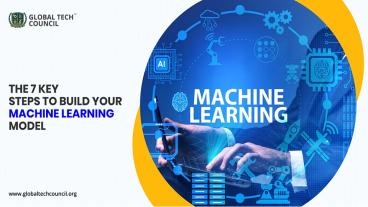The 7 Key Steps To Build Your Machine Learning Model - PowerPoint PPT Presentation
Title:
The 7 Key Steps To Build Your Machine Learning Model
Description:
A machine learning model is a file that has been trained to recognize certain types of patterns. You train a model over a set of data, providing it an algorithm that it can use to reason over and learn from those data. – PowerPoint PPT presentation
Number of Views:1305
Title: The 7 Key Steps To Build Your Machine Learning Model
1
- Session 1
2
- Several types of industries are executing
projects based on artificial intelligence and
machine learning for various applications. These
applications include pattern recognition,
conversational systems, predictive analytics,
personalization systems, and autonomous systems.
All these projects execute with the machine
learning models. Building and developing a
machine learning model is just like developing
any product but at a high level. Machine learning
training will provide you with deep knowledge and
understanding of the ML domain. In this blog, we
will discuss the steps to develop your machine
learning model.
3
Introduction
- A Machine learning model is a mathematical
depiction of real-word. You have to provide data
training to build machine learning models. Since
data is a fundamental concept of machine
learning. So, the data layer will be at the top
of the development process. So let's dive in and
understand the seven key steps of machine
learning model development.
4
Steps for machine learning model development
- There are seven steps for the development of
machine learning models. You cant ignore these
key steps of machine learning development if you
wish to be certified for machine learning
certification.
5
- 1. Identification of the business problem
- The first step of any ML-based project is to
understand the requirements of the business. You
need to develop an understanding of the problem
before attempting to decode it. Firstly,
understand the requirements and objectives of a
project. Then, reshape this knowledge into a
business problem definition. After that formulate
an opening plan for attaining the objectives of
the project.
6
- 2. Identification of data
- Once you identify the business problems the next
phase is to identify data. Firstly, you have to
understand how the model will work on real-world
data. A machine learning model is generated by
learning from train data and applying that
understanding to new data. The data needs to be
in good shape. This step involves data
identification, initial requirements, collection,
quality, and data insights. The main focus of
this step is to manage the quality and quantity
of data.
7
- 3. Collect and prepare the data
- The collection of data starts after the
identification of data. This step involves the
investigation of data. In this phase, you need to
shape your business data so that it further can
be utilized to train your business model. The
quality of data will directly impact how your
business model will operate. You can use web
scraping to gather information from several
sources. After gathering information the next
step is to prepare and visualize the data. This
step involves the pre-processing of data by
eliminating, normalizing, error corrections, and
removal of duplicacy. The preparation of data
consists of data cleansing, augmentation,
normalization, aggregation, transformation, and
labeling of data.
8
- 4. Choose and train your machine model
- At this stage, you develop an understanding of
your problem which you are trying to solve. Now
your data is also in its usable shape. Now it's
time to select and train your machine model.
There are many models that you can select
according to your business objectives. The step
of selection of models includes algorithms of
prediction, classification, clustering, deep
learning, linear regression, and so forth. Now
you will be required to train datasets to operate
smoothly. The step of training your machine model
involves several algorithms and techniques. The
outcome machine model can be used for evaluation
to check whether it meets the operational and
business requirements.
9
- 5. Evaluation
- This step involves the evaluation of the machine
models using a model metric approach, quality
measurements, datasets, and matrix calculations.
This phase is the quality assurance of a machine
learning approach. - 6. Experiment and adjustment of the model
- After evaluation, the adjustments of the machine
model comes. Now, it's time to see how it works
in the real world. This stage is also known as
model operationalizing. It includes the
deployment and monitoring of the ML model.
10
- 7. Interference or Prediction
- Now, it's time to utilize machine learning models
in real-life scenarios
11
Conclusion
- Once you get a direction and blueprint of your ML
model then you can test the prototype of your
solution. You should continuously look for
advancements and improvements to attain success
in the machine learning development model. - If you are a beginner and want to explore machine
learning for beginners, then you can check out
our website Global Tech Council.
12
(No Transcript)































